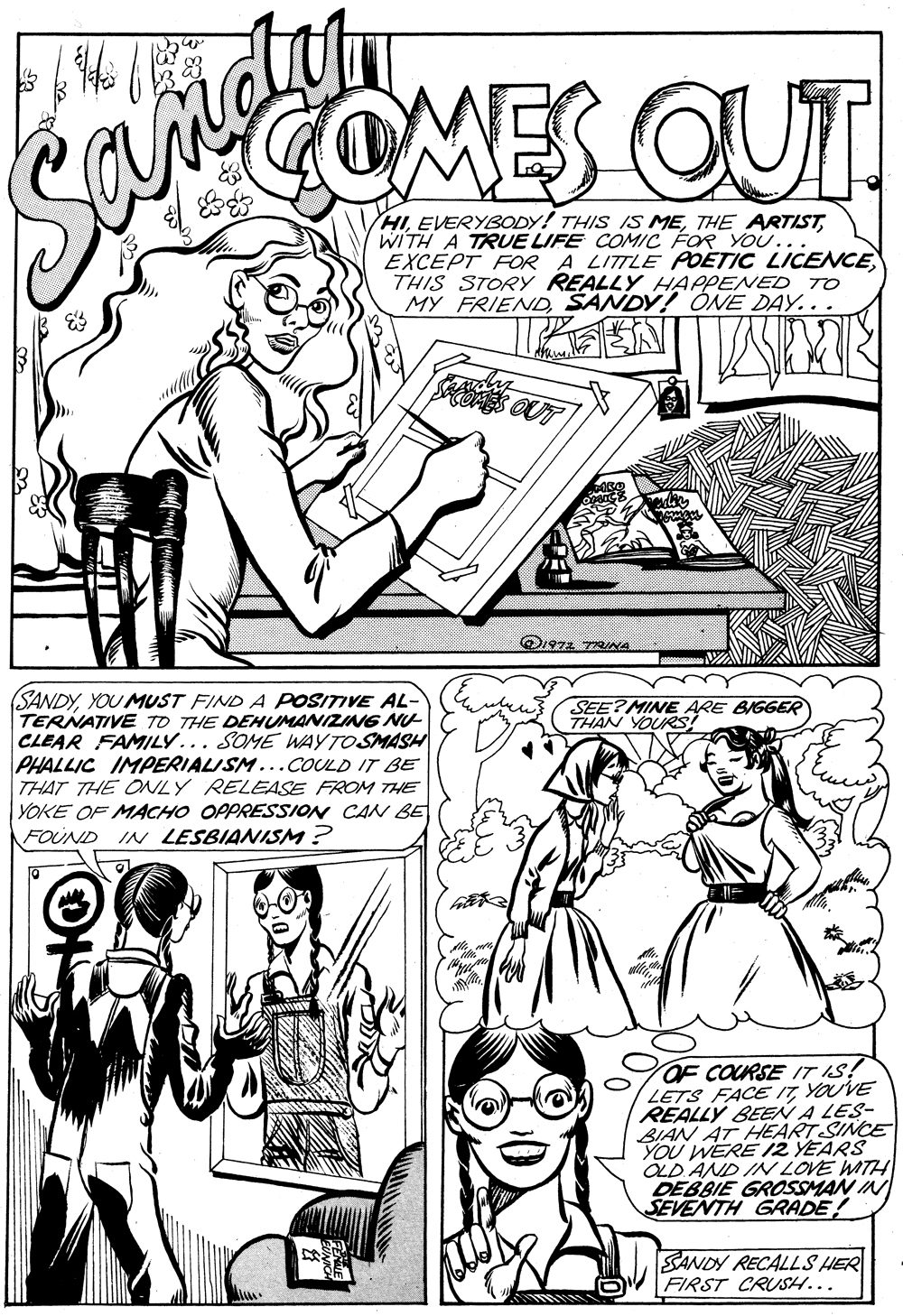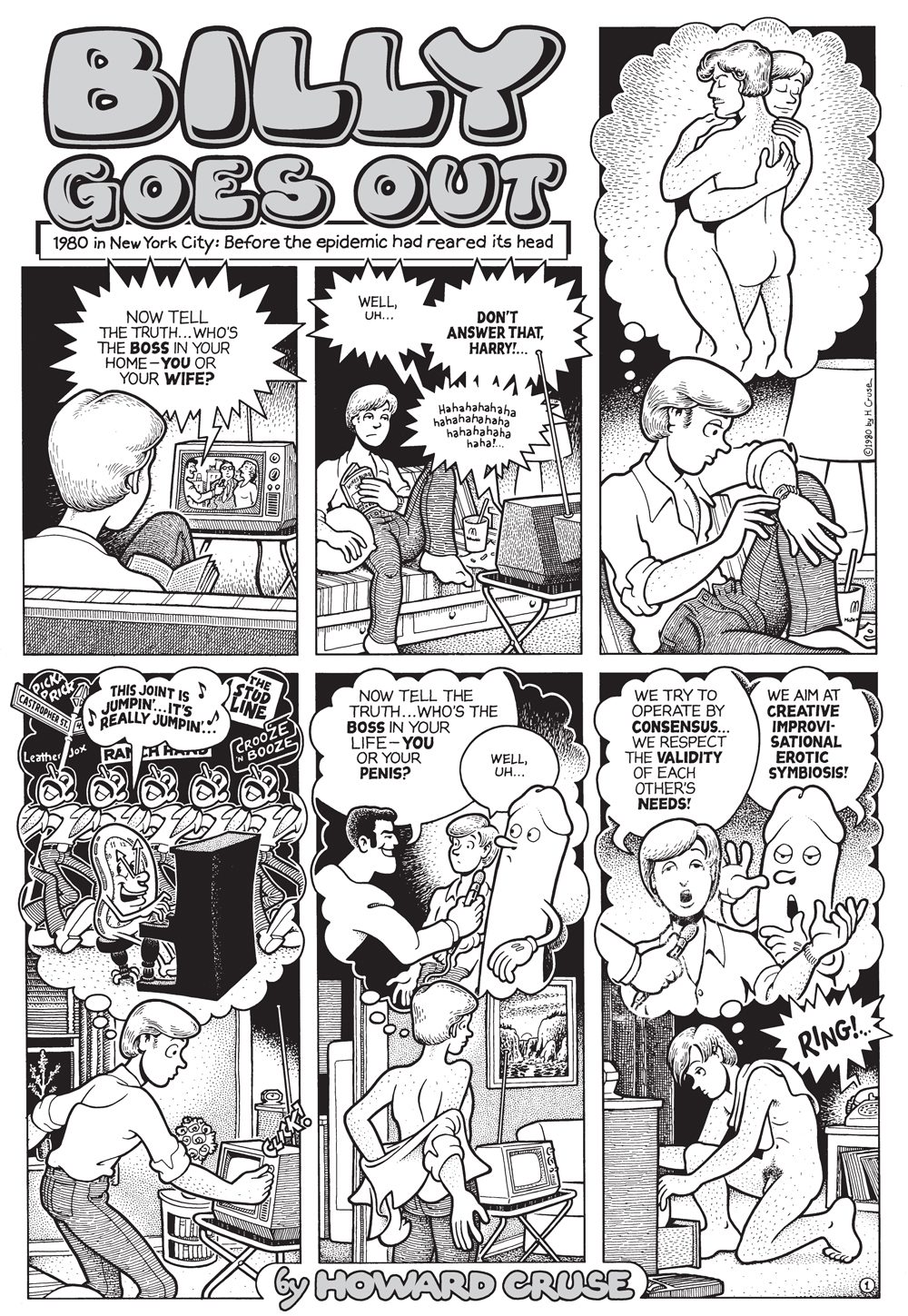Queer cartooning encompasses some of the best and most interesting comics of the last four decades, with creators tackling complex issues of identity and a changing society with intelligence, humor, and imagination. No Straight Lines, the new book published by Fantagraphics and edited by Justin Hall, celebrates this vibrant artistic underground by collecting four decades of excellent stories that can be enjoyed by all.
Justin Hall will be talking about and signing books in the Bay Area:
July 19th, 7-9pm, The Cartoon Art Museum
July 26th, 7:30-9:30pm, Castro Books Inc
July 28th, 7:30-9:30pm, Pegasus books
“Comics and gays. They go together well; after all they have one major thing in common: both tend not to get any respect.” -Jerry Mills, 1986
***
LGBTQ comics have fought a long, uphill battle for recognition. While comics have traditionally been dismissed as puerile and simplistic, queer cartooning has been even further marginalized within the comics world, rarely garnering shelf space in comic book stores or recognition in conventions and awards ceremonies. They have existed in a parallel universe alongside the rest of comics, appearing almost exclusively in gay newspapers and gay bookstores, and published by gay publishers. Queer comics have been largely insular creations designed for their own communities, and they have been neither interested in nor able to gain a wider market.
The insular nature of the world of queer cartooning, however, has created a truly fascinating artistic scene. LGBTQ comics have been an uncensored, internal conversation within queer communities, and thus provide a unique window into the hopes, fears, and fantasies of queer people for the last four decades. They have forged their aesthetics from underground comix, gay erotic art, punk zines, traditional illustration, camp humor, and the biting commentaries of bull dykes, nerdy fags, gender radicals, and other marginalized queers. They have analyzed their own communities, and their relationship with the broader society in smart, funny, and profound ways.
The visual nature of comics has been important for a community forging its self-image; as Alison Bechdel wrote when describing her creation of Dykes To Watch Out For, “I had set out… to make lesbians visible.” And that she did; many young queers struggling to come out and find their place in society discovered their first images of LGBTQ people in her strips and those of her fellow cartoonists.
Now the gay newspapers and bookstores are closing down and the bigotry against queer people and their stories is waning. LGBTQ cartoonists are moving out of the queer media ghetto and bringing their work to wider audiences. This, then, is the perfect moment to take stock of queer comics, to give them their due, and to chronicle their largely hidden history; this is the moment to celebrate a world with no straight lines.
COMICS COME OUT: GAY GAG STRIPS, UNDERGROUND COMIX, AND LESBIAN LITERATTI
The first queer comics, those manifestations of underground art and revolution in ink, were first and foremost about gay sex. Touko Laaksonen can be considered the first gay cartoonist, as he was producing his underground, erotic comics as early as the mid-1940’s, and selling them through a mail-order business in Europe. In 1957 he began creating illustrations for Physique Pictorial magazine in the U.S., for which he was coined the pen name Tom of Finland. Pirated copies of his comics made the rounds in the U.S., but it wasn’t until the loosening of the obscenity laws in the 1960s that Laaksonen, along with his contemporaries who were making erotic comics and illustrations, was finally able to distribute his erotic work openly. He remains, years after his death in 1991, the most influential creator of gay erotica in the world, and his wordless adventures of the sexually insatiable leatherman Kake have inspired generations of cartoonists, as well as other artists and lusty viewers.
Alongside this flowering of erotic material came the birth of the modern gay-rights movement, sparked by the famous Stonewall riots of 1969. The movement was borne along by a wave of gay newspapers and magazines, the longest running being the Advocate, begun in 1967. These new gay papers needed comics, and so gay gag strips such as Joe Johnson’s Miss Thing and Sean’s Gayer Than Strange began to appear.
While the nascent gay liberation movement was taking to the streets, underground comix (which spelled comics with an “x”) were exploding in San Francisco. Robert Crumb published the first issue of Zap Comix in 1968, which he first sold out of a baby carriage that he pushed through the Haight-Ashbury neighborhood, and then later through the hippie head shops. Other comix artists (virtually all of them straight men) joined Crumb, but the material they were producing, while breaking boundaries with their depictions of sex, drugs and other adult subject matter, tended toward misogyny and homophobia.
Trina Robbins was one of the most prominent exceptions to these trends; on arriving in San Francisco in 1970, she put together It Ain’t Me, Babe Comix, the first all-female comix anthology. Two years later, she joined up with a crew of other women creators and local publisher Last Gasp to create the Wimmen’s Comix collective. For the inaugural issue, Robbins produced Sandy Comes Out, the first comic about a lesbian that was neither derogatory nor erotic.
The story also happened to be about Robert Crumb’s sister Sandy, who had arrived in the Bay Area to stay with her famous brother Robert after a divorce had left her and her baby with nowhere else to go. Robert wasn’t happy about her staying with him and continually tried to pass her off to his male cartoonist buddies, much to Sandy’s dismay. Robbins swept in and offered Sandy a place to stay; they were roommates for a time, and remained friends afterwards.
Shortly after moving out of Robbins’ apartment, Sandy came out of the closet, eventually moving into a gay, hippie commune in San Francisco. Sandy told Robbins about her experiences, which inspired Robbins to create Sandy Comes Out, with Sandy’s help on the script. History was made; the story was the proverbial stone dropped in the pond, creating ripples that eventually grew into an LGBT comics movement.
Mary Wings was a ceramics major living in Oregon and fresh out of the closet herself when she read Sandy Comes Out; she was immediately inspired to create her own comic. As she later said, “In those days of identity politics, only a lesbian could really tell the story of coming out, so I hastened to do a rejoinder to Trina’s story. It was as if Sandy came out, went to the bar, took karate lessons, and that was it. There was an emotional and spiritual side to coming out that wasn’t there.”
Thus, Come Out Comix was born in 1973 on a photocopy machine in the basement of a local radical women’s karate school. In the back of the comic was an address: readers could order more copies directly from the artist for one dollar. Come Out Comix was raw, but it was earnest. It was also the world’s first lesbian comic book. Wings eventually made a bigger name for herself in another medium by creating the first lesbian detective novels.
Around the same time, the Spanish cartoonist Nazarrio was forming a collective of underground comix creators in Barcelona. This was the time of Franco, and the artists were regularly harassed by the authorities; despite the danger, Nazarrio introduced radical queer elements into his work from early on, culminating in the edgy, transgender detective Anarcoma.
Back in San Francisco, Larry Fuller, one of the very few African-Americans in the comics industry, published the racy Gay Heartthrobs in 1976, with art by Mike Kuchar and others. Unlike previous gay erotic comics, Heartthrobs was produced in the standard comic book format, as opposed to chapbooks or folio books, enabling it to be sold in comic book stores and tying it more closely to the larger comics world.
During the same year, Roberta Gregory published Dynamite Damsels, in outrage that a straight woman had created the first story about a lesbian (Sandy Comes Out), much as Come Out Comix had been. Gregory emerged as a true comics prodigy, and the book was the first continuing series self-published by a woman, queer or straight.
The success of these early LGBTQ comix inspired Dennis Kitchen, the owner of Kitchen Sink Press, to publish an anthology that would explore gay life in a substantial way. Being straight, Kitchen realized he needed to enlist an openly gay creator to be the editor of the series. He went to his friend Howard Cruse, who was producing the comix series Barefootz at the time. For Cruse it was an exciting opportunity but terrifying as well, since it meant publicly coming out of the closet in an industry that was highly intolerant. Still, Cruse had already tested the waters earlier with Gravy on Gay, a Barefootz story about a gay character, and was encouraged by the response. He agreed to helm the project, and Gay Comix was borne.
Cruse and Kitchen had no way of knowing who in the heavily closeted comics industry was actually queer and willing to contribute to such an anthology, so they, in Cruse’s words, “did everything but drop leaflets out of helicopters to spread the word about our project.” In a mimeographed letter sent to virtually every underground cartoonist the two could think of, Cruse called for stories of “emotional authenticity” that were “about people, not genitals,” in order to move the series out of the campy erotica of Gay Heartthrobs and closer to the depth of the lesbian comics.
To Cruse’s delight, the two pioneers Wings and Gregory agreed to contribute, along with Lee Marrs, who was one of the founders of Wimmen’s Comix, as well as the creator of the acclaimed Pudge, Girl Blimp, a contributor to mainstream comics, and an open bisexual. Cruse collected material from several other creators, contributed his own story Billy Goes Out, and Gay Comix #1 hit the stands in 1980, ushering in a new era of LGBTQ comics. Cruse became known as the godfather of queer comics, both for his role in the creation of Gay Comix, and for his exceptional cartooning skills, which were fully realized in his groundbreaking 1995 graphic novel Stuck Rubber Baby.
***
Look for Part 2 of this post tomorrow.








